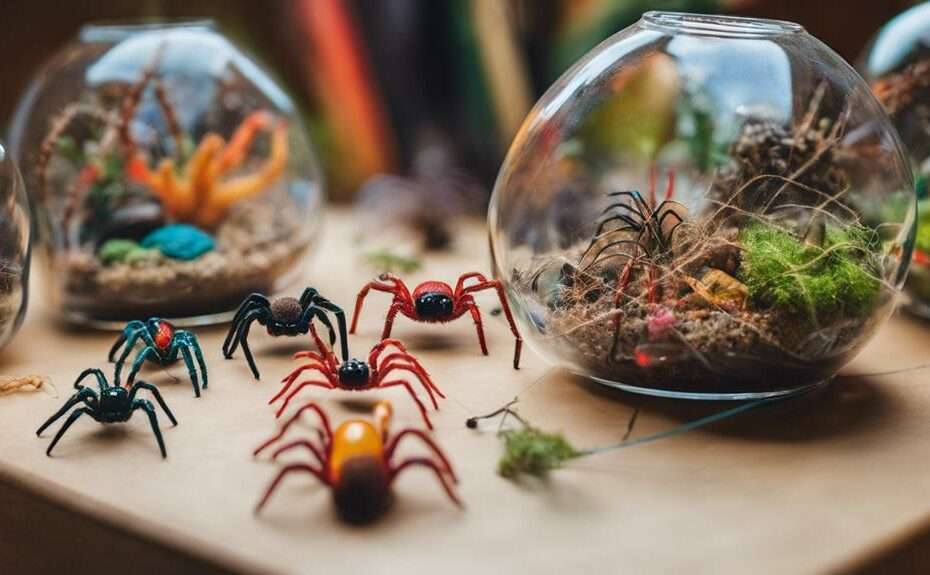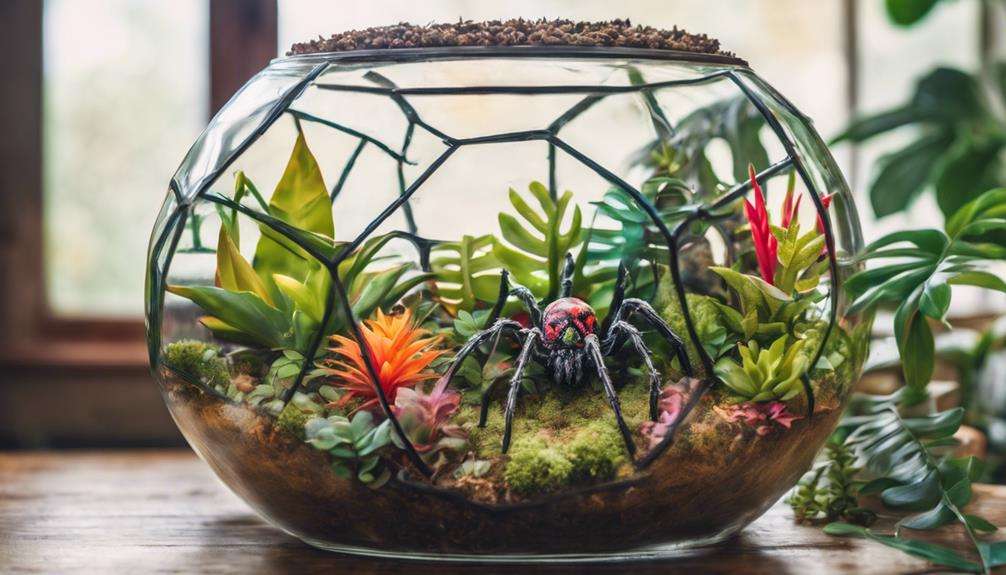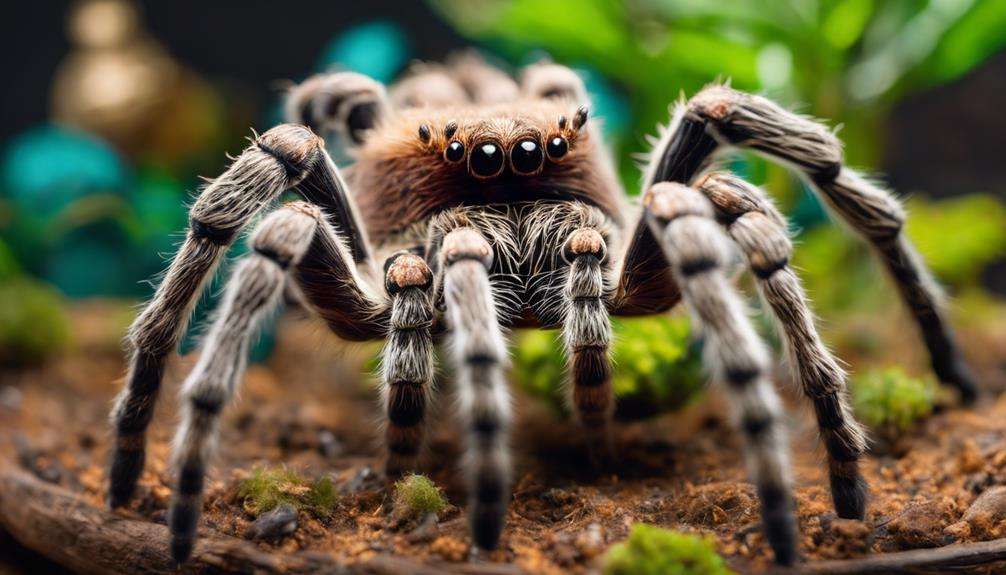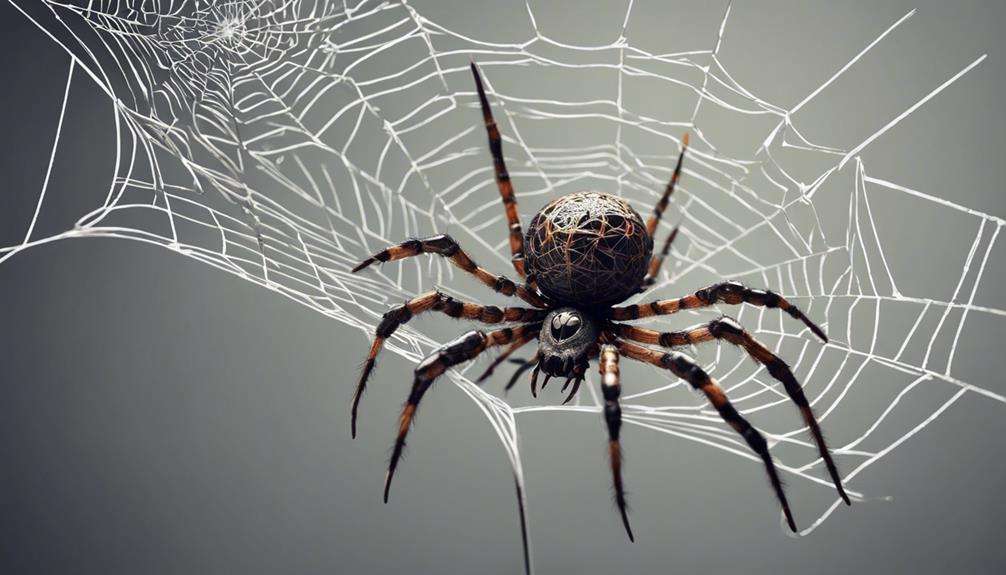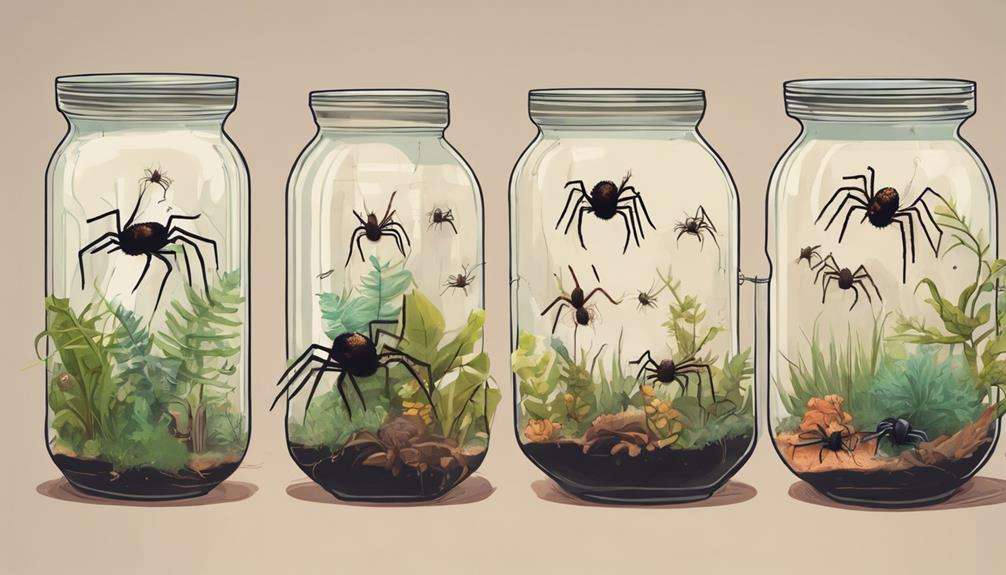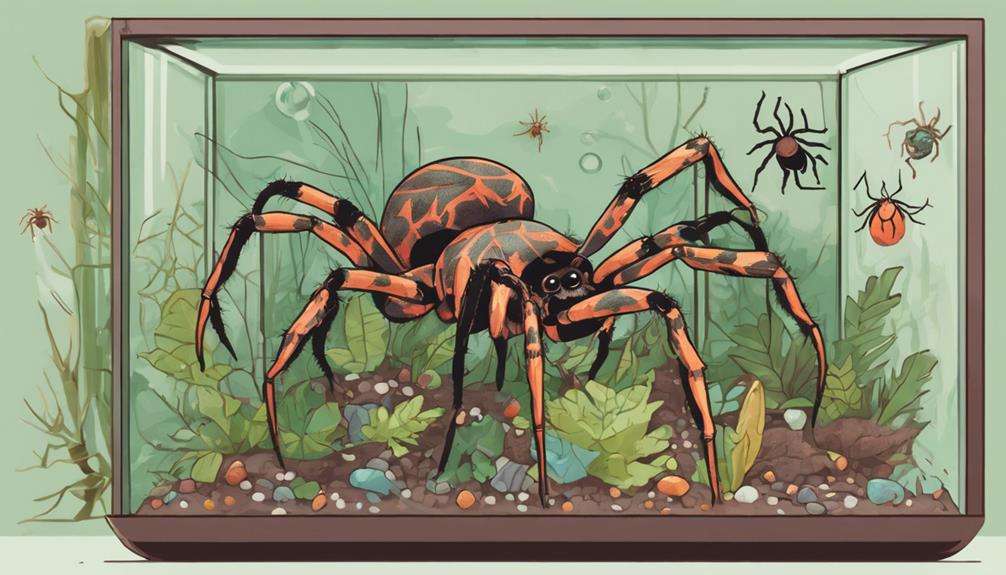Curious about how pet spiders can enhance your educational journey?
Imagine the allure of observing these eight-legged wonders up close, learning about their intricate lives and behaviors.
From the mesmerizing patterns of their webs to the way they capture prey, there is much to uncover when it comes to these fascinating creatures.
But what makes them such valuable educational tools?
Stay tuned to discover the engaging world of pet spiders and how they can enrich your quest for knowledge in surprising ways.
Key Takeaways
- Beginner-friendly tarantulas like Chilean Rose and Pink-Toed are ideal for educational enthusiasts.
- Spider behaviors include unique adaptations, hunting strategies, and communication methods.
- Understanding nutrition, feeding habits, and balanced diets are crucial for spider well-being.
- Spiders play vital roles in ecosystems by controlling insect populations and aiding in nutrient recycling.
Unique Tarantula Species for Education
When considering unique tarantula species for educational purposes, the Chilean Rose Tarantula stands out as a popular choice due to its distinctive pink or blue body hairs and gentle demeanor. This species, also known as the Chilean Flame Tarantula, is beginner-friendly, making it an excellent option for those looking to explore into the world of arachnids.
The Mexican Red-Knee Tarantula, native to regions from North Mexico to Panama, is another enchanting choice. With its colorful legs and impressive longevity, this tarantula species offers a visually striking addition to any educational setting.
If you're seeking a pet spider with a distinctive appearance, the Curlyhair Tarantula might be the perfect fit. Its woolly appearance and low likelihood of health issues make it a great introductory pet for enthusiasts.
Pink-Toed Tarantulas, recognized for their friendly nature and vibrant orange-pink-tipped feet, are ideal for beginners looking to study these fascinating creatures up close.
Additionally, the Costa Rican Zebra Tarantula, featuring striking white knee stripes, requires specific temperature and humidity levels for best care, adding an educational dimension to tarantula husbandry.
Spider Behavior Insights for Learning
Exploring spider behavior provides invaluable insights into their intricate hunting strategies, mating rituals, and unique adaptations. Observing spider communication offers educational opportunities, shedding light on their social interactions and warning mechanisms.
Understanding the diurnal activity of spiders reveals how they adapt to different light conditions, affecting their behavior and hunting patterns. Spider web construction showcases their impressive skills, with different species creating diverse webs suited to their hunting techniques, from orb-weavers to funnel weavers.
Studying spider movement patterns uncovers fascinating aspects of their hunting strategies, such as ambush predation or active hunting. By delving into these behaviors, enthusiasts gain a deeper appreciation for the complexity and diversity within the spider world, opening doors for educational experiences that go beyond mere observation to a true understanding of these remarkable arachnids.
Educational Feeding Habits of Spiders
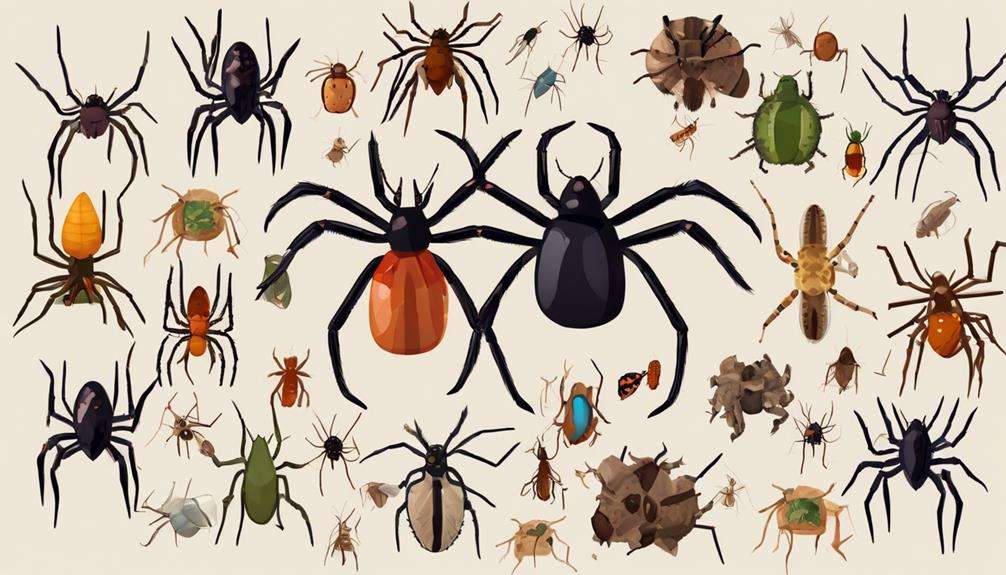
Spiders employ a variety of feeding techniques based on their hunting styles and prey preferences. Some species use venom to paralyze their victims, while others rely on intricate web structures to ensnare unsuspecting insects.
Understanding the nutritional needs of different spiders is vital for their well-being in captivity.
Spider Feeding Techniques
With their diverse and unique feeding habits, spiders showcase a fascinating array of strategies for capturing and consuming prey. Some species, like jumping spiders, rely on their exceptional vision to stalk and capture prey actively. Others, such as orb weavers, construct intricate silk webs to ensnare flying insects, displaying remarkable feeding techniques.
Tarantulas, known for their specialized feeding behavior, primarily depend on venom to subdue their prey before feeding on them. This venom not only immobilizes the prey but also aids in the digestion process. The various feeding habits of spiders highlight their adaptability and efficiency in securing nutrition in their ecosystems, making them intriguing subjects for educational enthusiasts.
Nutritional Needs of Spiders
To meet the nutritional needs of spiders effectively, understanding their diverse feeding habits is essential for ensuring their health and well-being.
Spiders exhibit carnivorous diets, preying on insects like crickets, flies, and mealworms. While some species are specialized hunters that actively pursue their prey, others rely on web traps to catch their food.
Feeding frequency varies among spiders, with some requiring regular meals while others can go weeks without eating.
Spiders use venom to immobilize and digest their prey before consuming them. It's important to comprehend the nutritional needs of spiders to provide a balanced diet that promotes ideal growth and vitality in these fascinating arachnids.
Safety Tips for Spider Education
Regularly supervising spider handling sessions during educational activities is important to prevent accidents and guarantee the safety of all participants involved. When handling spiders, it's essential to use proper techniques such as gently coaxing them onto hands to minimize stress.
Educating participants on potential risks, like allergic reactions to spider venom or hairs, is critical for their safety. Providing clear instructions on how to approach, touch, and observe spiders respectfully can help prevent accidents and guarantee spider safety.
Encouraging hand washing after handling spiders is crucial to prevent potential health issues. This practice can help reduce the risk of transferring any harmful substances from the spider to oneself or others. By promoting hand washing, you can mitigate the chances of skin irritation or other allergic reactions that may arise from contact with spiders.
Health Awareness in Spider Keeping

To maintain your pet spider's health, remember that regular hydration is vital to prevent dehydration.
Maintaining a clean enclosure is essential in warding off mites and fungal infections.
Recognizing signs of stress and molting, as well as mastering proper handling techniques, are key components of spider health care.
Spider Nutrition Basics
When considering spider nutrition basics for peak health in your pet arachnid, ensuring a balanced diet rich in essential nutrients is paramount. Spider nutrition primarily involves feeding live insects such as crickets and roaches, which provide the necessary nutrients for your spider's well-being.
A balanced diet is vital for supporting the molting process and overall growth. Some spider species may benefit from additional dietary supplements to ensure optimal health and vitality.
It's important to monitor feeding frequency, adjust portion sizes according to your spider's size and activity level, and maintain a nutritional balance to prevent issues like obesity or stunted growth. By paying attention to these factors, you can promote your pet spider's health and longevity.
Common Health Issues
Common health issues in spider keeping, such as dehydration, mites, and fungal infections, can greatly impact the well-being of these arachnids.
Ensuring proper hydration through a water source like a small dish or misting is essential. Regularly cleaning the spider's enclosure helps prevent mites and fungal infections, as these thrive in unclean environments.
Monitoring your spider's health and behavior is vital for early detection of any potential health issues. Educate yourself on the specific care requirements of your spider species to proactively manage its health.
Engaging Educational Spider Activities
To engage in educational spider activities, consider setting up a spider terrarium with at least two compartments. This setup allows for observing predator-prey relationships and diverse spider behaviors. Incorporate live plants to mimic a mini ecosystem, providing a natural environment for the spiders to exhibit their behaviors.
Utilize this space to witness intriguing activities like molting, revealing the growth and regeneration process of these arachnids. Additionally, explore the unique adaptations of spiders, such as silk production for web-building and venom for hunting, enhancing your understanding of biodiversity.
Studying the hunting techniques of different spider species can offer valuable insights into their role in the ecosystem. By closely observing these fascinating creatures in a controlled environment, you can gain a deeper appreciation for the complexity of spider behavior and their contributions to the natural world.
Frequently Asked Questions
What Is the Friendliest Spider to Have as a Pet?
If you want the friendliest spider as a pet, the Pink-Toed Tarantula is a top choice. Their docile nature and interactive behaviors offer a unique bonding experience. Provide a tall tank with climbing spaces for their active lifestyle.
Are Spiders Good Classroom Pets?
Spiders make excellent classroom pets for educational benefits. They offer interactive learning through observing behaviors, diverse species, and feeding habits. Handling safety, pet care, and enclosure setup teach responsibility. Expect lifespan to vary.
What Is the Friendliest Spider in the World?
The friendliest spider in the world is the Pink-Toed Tarantula. These gentle giants are docile creatures, making them excellent furry companions for educational enthusiasts. They are curious buddies that exhibit intelligent behaviors, perfect for observing in a controlled environment.
What Are the Most Intelligent Spider?
When it comes to spider intelligence, Portia spiders stand out with their problem-solving skills, cognitive abilities, and remarkable learning behavior. Their memory capacity, adaptation strategies, and communication methods showcase advanced cognitive capabilities in the arachnid world.
Conclusion
You may have concerns about the safety of keeping pet spiders, but with proper care and precautions, they can be fascinating educational companions.
By understanding their behavior, feeding habits, and health needs, you can create a safe and enriching environment for these intriguing creatures.
Embrace the opportunity to learn from these unique tarantula species and engage in educational activities that will deepen your understanding of the fascinating world of arachnids.
